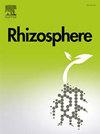影响白芨新发纤维根生长和品质的生态因子研究
IF 3.5
3区 生物学
Q1 PLANT SCIENCES
引用次数: 0
摘要
白芨的纤维根通常是该植物的非必需部分,但研究表明,它们含有与块茎相同的活性成分,表现出更强的抗氧化特性,使其具有药用价值。作为中医治病防病的基础材料,药材的产量和质量直接关系到其临床疗效。这些药用植物的生长和品质受各种环境因素的影响。本研究集中在三个不同地区的新生长的条纹草纤维根。我们分析了这些地区的条纹柏纤维根的生长性状、物理特性、生物活性成分、抗氧化特性、整体质量、生长环境、土壤肥力和微生物特性,以确定这些因素如何共同影响这些地区条纹柏纤维根的生长和质量。不同地区的条纹草纤维根的生长性状、物理品质、总酚含量和抗氧化活性差异显著。云岩区多糖含量最高(4.42%),石冰县最高(4.57%)。总酚含量最高的是亳州区,为8.39 mg/g。主成分分析表明,云岩地区纤维根的综合质量明显高于亳州地区。Mantel进一步分析表明,气候因子主要影响根系生长特征,土壤肥力指标主要影响根系品质积累。在土壤微生物中,只有细菌显著促进了纤维根中多糖和总酚的积累。结论本研究为白条根的资源潜力提供了参考,揭示了人工栽培药用植物的生态因子与药用特性之间的复杂关系。本文章由计算机程序翻译,如有差异,请以英文原文为准。
Study on ecological factors influencing growth and quality of newly developed Bletilla striata fibrous roots
The fibrous roots of Bletilla striata are typically non-essential parts of the plant, yet studies have shown that they contain the same active components as the tubers, exhibiting even stronger antioxidant properties, making them promising for medicinal applications. As the foundational material for traditional Chinese medicine in both treatment and disease prevention, the yield and quality of medicinal products are directly linked to their clinical efficacy. The growth and quality of such medicinal plants are shaped by various environmental factors. This study focuses on newly grown fibrous roots of B. striata from three distinct regions. We analyzed their growth traits, physical characteristics, bioactive components, antioxidant properties, overall quality, growth environment, soil fertility, and microbial characteristics to determine how these factors collectively influence the growth and quality of B. striata fibrous roots across these regions. The growth traits, physical quality, total phenolic content, and antioxidant activity of B. striata fibrous roots differed significantly among regions. Yunyan District exhibited the highest polysaccharide content (4.42 %), while Shibing County showed the highest militarine concentration (4.57 %). The highest total phenol content (8.39 mg/g) was recorded in Bozhou District. Principal component analysis indicated that fibrous roots from the Yunyan area exhibited a notably higher comprehensive quality than those from Bozhou. Mantel's analysis further revealed that climatic factors primarily affected root growth characteristics, while soil fertility indicators influenced quality accumulation in the roots. Among soil microorganisms, only bacteria significantly promoted the accumulation of polysaccharides and total phenolics in the fibrous roots.
Conclusion
This study provides a reference for the resource potential of B. striata fibrous roots, offering insights into the intricate relationships between ecological factors and the medicinal properties of artificially cultivated medicinal plants.
求助全文
通过发布文献求助,成功后即可免费获取论文全文。
去求助
来源期刊

Rhizosphere
Agricultural and Biological Sciences-Agronomy and Crop Science
CiteScore
5.70
自引率
8.10%
发文量
155
审稿时长
29 days
期刊介绍:
Rhizosphere aims to advance the frontier of our understanding of plant-soil interactions. Rhizosphere is a multidisciplinary journal that publishes research on the interactions between plant roots, soil organisms, nutrients, and water. Except carbon fixation by photosynthesis, plants obtain all other elements primarily from soil through roots.
We are beginning to understand how communications at the rhizosphere, with soil organisms and other plant species, affect root exudates and nutrient uptake. This rapidly evolving subject utilizes molecular biology and genomic tools, food web or community structure manipulations, high performance liquid chromatography, isotopic analysis, diverse spectroscopic analytics, tomography and other microscopy, complex statistical and modeling tools.
 求助内容:
求助内容: 应助结果提醒方式:
应助结果提醒方式:


